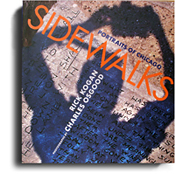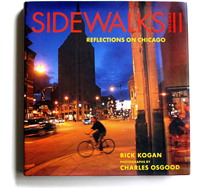

 |
 |
 |
 |
Excerpts from Sidewalks II
FIGHTING FOR A FRESH START
Most of those in the largely male crowd of a couple hundred were standing. More than a few were drinking. A surprising number were smoking. A few were filled with bloodthirsty expectation. "Let's get it on!" screamed one crew-cut man to no one in particular. "Let's see some action." He was downstairs in one of the cavernous rooms of the sprawling entertainment complex known as 115 Bourbon Street, at 3359 West 115th Street in south suburban Merrionette Park. He and the others were awaiting a series of boxing matches to be held in the regulation-size ring that towered over the floor, illuminated by almost blindingly bright lights.
In a large room upstairs (as seen in Osgood's photo), there was plenty of action as young men, teenagers, really, shadowboxed, skipped rope, and otherwise prepared for their bouts under the concerned eyes and whispered counsel of parents, coaches, or trainers.
You may not realize it, but boxing matches are a frequent and popular diversion around the area. They take place regularly in gymnasiums and in such larger venues as the Aragon, Cicero Stadium in Cicero, Sabre Room, and 115 Bourbon Street, where you can see for yourself on the third Wednesday of every month.
You might meet Martin McGarry, who, when not working as a union pipe fitter for Local 597, runs McGarry's Boxing Club on the Far South Side.
"The boxing scene here is very healthy," said McGarry, a native of Ireland and, when he was younger, an accomplished boxer there and in England. "More people are getting involved. There are some very good amateur fighters here. Some of the kids in this room, maybe a few of them, have thoughts of turning professional one day. But a lot do it for exercise, or to learn how to protect themselves."
The proceeds from the boxing matches on this night will benefit the First Chance Program of the Police Athletic League of Illinois. Jerry Elsner, director of PAL and executive director of the Illinois State Crime Commission, was standing ringside.
"Look, a kid can get in trouble a lot of ways," he said. "Let's say he's at a party where the police find dope, or he's busted at a party for underage drinking. Well, that goes on his record, and—this is the computer age—it stays there. But a kid gets in our program and does what he needs to, the charges will be dropped."
McGarry said: "This is a great program. A lot of kids get jammed up on something innocent. This enables them to get back on the right track. A lot of these at-risk kids get involved in boxing programs. But what I tell my kids is that they don't have to fight competitively to gain great self-esteem and confidence … to get on the right track, to have a good life."
April 8, 2007
YOUTH MOVEMENT
It is early on a cold Saturday morning. Winter hangs on hard and gray; snow is pasted to patches of ground that, soon enough, will be green with grass. One by one they start to arrive, a dozen tiny children. Some of them come on foot and a couple, regally, in strollers. A few are cradled in a mother's or father's arms.
Most are girls. One is a boy. Once inside the Hyde Park Neighborhood Club, they begin to shed their coats and hats and boots and scarves and emerge a pack of pink. The boy is not wearing pink. "I'm a ballerina," says one and then another and another. The boy does not say this. There are many activities going on in this building. There are organized basketball games, filled with exuberant teenagers. There are gentle-looking exercise classes for those no longer limber of limb. A few people can be seen on blue floor mats in a room with the lights low—yoga, it appears.
For most of the winter and into the spring the little ballerinas, and the boy, have been part of one of the many classes that make up the "curriculum" of the Hyde Park School of Dance. Their Creative Movement class is formally described as "exploration of dance movement with the use of imagery, such as dancing elephants and beautiful butterflies, as inspiration." None of them is able to read that description.
"I'm a bee," says one, hopping about the studio, and then another and another: "I'm a bee."
We are there on the one Saturday parents and other kin and friends are allowed to observe the thirty-minute class. The studio's walls are lined with people whose faces are stuck in smiles and whose eyes peer through video or still cameras. Among the faces are those of Kurt and Jennifer Elling; he the great jazz singer just back from touring in Asia, she a former professional ballet dancer and still a teacher, and they, together, the parents of the youngest dancer in class, Luiza Jade, not yet three.
"We are so fortunate to have the school thriving here on the South Side," says Jennifer Elling. "I have taught here on and off over the years. It's a beautiful experience watching and helping young dancers grow. I realize even more how important the school is now that Luiza is here."
The woman teaching the Creative Movement class is August Tye. She is the founder and artistic director of the school. When it started in 1993, she was its only teacher. There were thirty students. Currently there are ten faculty members and more than three hundred students. Tye has a wonderful career in dance. She was a member of the Joel Hall Dancers, Salt Creek Ballet, and Second City Ballet. She works with the Lyric Opera, most recently as the revival choreographer for its production of Eugene Onegin. She is married to an opera singer and the couple has two daughters, ages four and eight, who are students at Mom's school. Tye teaches as many as fifteen classes a week, for kids of all ages and adults, but she finds a special pleasure in her littlest dancers.
"There is a great joy in the natural creativity kids have at this age. I guide them, experiment with movement," she says. "I see their confidence being built. I see them having a great time. I see all those perfectly limber little bodies falling in love with dance."
But there are so many things in which to fall in love in the tender years—a cloud, a leaf, or a color. And so, not far from the dance studio, we are in a room that, again, is a mess.
It has been this way every Tuesday for the last couple of months, when it has been occupied for ninety minutes by six kids between the freewheeling ages of three and five. And so, on this day, one little girl has glued a couple of fingers together. Another has drawn a large "F" on her hand.
"I want a pink balloon," says one of these pint-sized Picassos, though the day's project, a Halloween mask, wouldn't seem to call for such an item.
Pinned to the walls of this classroom at the Hyde Park Art Center are works by older kids and, if one was to make quick judgment, these would be deemed more accomplished. But it is in this Discover Art class that one gets a vivid reminder of the unbridled creativity of kids.
The class is one of dozens offered at the Hyde Park Art Center for children and adults. The teacher is a young woman of great imagination and admirable patience named Sara Holwerda. There she is in Osgood's photo, holding an item made by one of the older kids.
"My dad is a painter, and I have always had access to art supplies and grew up with the idea that being creative was a daily activity," she says. "My dad taught me a few things directly, but mostly I hung out around his studio. Sometimes I'd entertain myself with puppet shows."
After graduating from the University of Michigan School of Art and Design, she moved to Chicago in 2006 and started teaching at the Hyde Park Art Center. "I teach summer camps, workshops, and a few adult classes, including Acrylic Painting and Creative Process. Creative Process is sort of an interdisciplinary workshop where we work on creativity and do things to be more prolific and think more freely…like children."
THE STREET OF SARIS
Show me a more interesting Chicago street than Devon Avenue. Traveling its length is, in essence, a unique experience of sights and sounds, like a trip around the world. The shops cluster together, a panorama of different ethnic goods, foods, and services. Whenever Osgood and I get depressed by some new ticky-tacky townhouse complex, or the appearance of yet another Starbucks, we take a trip to this street.
We are not looking for anything specific, just eager to walk around, for we know that we will be reminded of the glorious diversity of the city and of its ability to be hospitable to almost anyone who wants to stake a claim. This is a street, 6400 north for those of you who don't venture out much, that pleasantly assaults the eye and the other senses with a wild mix of signs and styles and faces. A friend of ours once said, "Devon looks like the back lot of some movie studio, with a million extras wandering around."
Among the most visually stimulating sights here are the sari shops, most of which are spaced along a few blocks on either side of Western Avenue. The oldest of them have been here since the mid-1970s, when Indians and Pakistanis began moving to the neighborhood in significant numbers. In any given year since, between fifteen and twenty sari stores have coexisted on a strip that is less than a mile in length.
There is almost no comparable concentration of similar businesses in the city, except perhaps for the saloons crowding Division and Rush Streets, or the financial institutions on LaSalle Street.
To the untrained eye—and Osgood and I are far from knowledgeable about fashion—the stores appear little different from one another.
Their windows are alive with brightly colored fabrics, some with intricate designs full of meaning—reflecting, for instance, the changing seasons.
The sari is many centuries old and is, basically, a six- or seven-yard piece of fabric that is draped artfully—with the aid of pleating and tucks, and over a drawstring underskirt and blouse—on the body to make the most elegant of outfits.
"There are basically two kinds of saris," says Manohar Thadani, who with his wife, Shreen, has operated Sari Sapne, 2623 West Devon Avenue, since 1986. "Ones made of silk and embroidered are generally worn for fancy or formal occasions. "Others are made of polyester imported from Japan. These less-expensive polyester saris are not available in India, so many are bought here by people who are going back to India to visit relatives. In India, the sari is everyday wear."
The saris at Sari Sapne are in the ten- to four-hundred-dollar range, but other stores have prices of one thousand dollars and more. It's a competitive market. "Very competitive during the day," says Thadani. "But at night we get together and have a party."
September 19, 1999
 Go to praise for Sidewalks books
Go to praise for Sidewalks books

